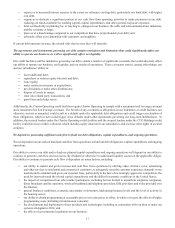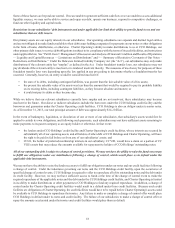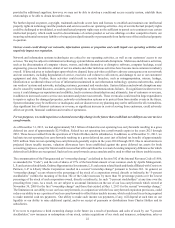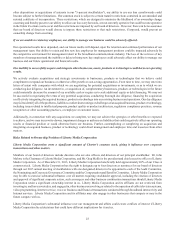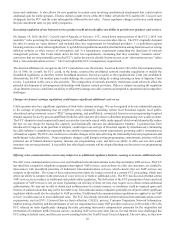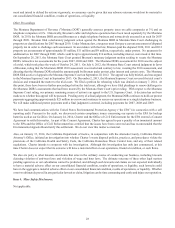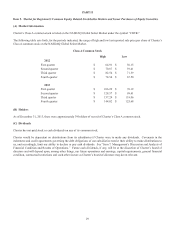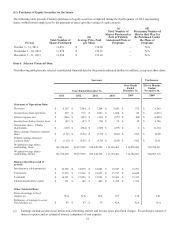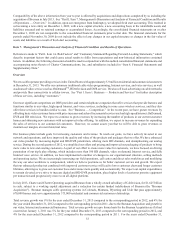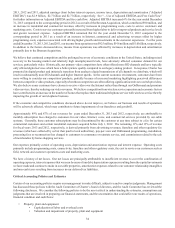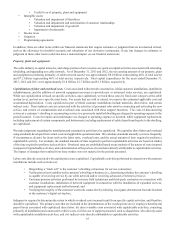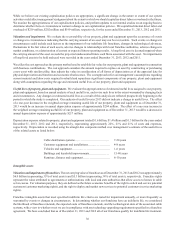Charter 2013 Annual Report Download - page 41
Download and view the complete annual report
Please find page 41 of the 2013 Charter annual report below. You can navigate through the pages in the report by either clicking on the pages listed below, or by using the keyword search tool below to find specific information within the annual report.
27
stand, will result in a substantial decrease in intercarrier compensation payments over a multi-year period. We received intercarrier
compensation of approximately $21 million, $19 million and $23 million for the years ended December 31, 2013, 2012 and 2011,
respectively. Further, the FCC’s recent initiative to collect data concerning certain point to point transport (“special access”)
services we provide could result in additional regulatory burdens and additional costs.
Item 1B. Unresolved Staff Comments.
None.
Item 2. Properties.
Our principal physical assets consist of cable distribution plant and equipment, including signal receiving, encoding and decoding
devices, headend reception facilities, distribution systems, and customer premise equipment for each of our cable systems.
Our cable plant and related equipment are generally attached to utility poles under pole rental agreements with local public utilities
and telephone companies, and in certain locations are buried in underground ducts or trenches. We own or lease real property for
signal reception sites, and own our service vehicles.
Our subsidiaries generally lease space for business offices. Our headend and tower locations are located on owned or leased parcels
of land, and we generally own the towers on which our equipment is located. Charter Holdco owns the land and building for our
St. Louis corporate office. We lease space for our offices in Denver, Colorado and for our corporate headquarters in Stamford,
Connecticut.
The physical components of our cable systems require maintenance as well as periodic upgrades to support the new services and
products we introduce. See “Item 1. Business – Our Network Technology.” We believe that our properties are generally in good
operating condition and are suitable for our business operations.
Item 3. Legal Proceedings.
Patent Litigation
Ronald A. Katz Technology Licensing, L.P. v. Charter Communications, Inc. et. al. In 2006, Ronald A. Katz Technology Licensing,
L.P. filed a lawsuit against Charter and other parties in the U. S. District Court for the District of Delaware alleging that Charter
and the other defendants infringed its interactive call processing patents. In 2007, the lawsuit was combined with other cases filed
by Katz in a multi-district litigation proceeding in the U.S. District Court for the Central District of California for coordinated and
consolidated pretrial proceedings. In 2010, the court denied Katz's motion for summary judgment, struck two affirmative defenses
that Charter had raised, invalidated one of the nine remaining claims Katz had asserted and entered a ruling restricting Katz's
damages claims by limiting the time period from which Katz may seek damages. A consolidated appeal involving other co-
defendants was held, with the U.S. Court of Appeals for the Federal Circuit confirming invalidity of certain claims and remanding
certain rulings back to the district court for further consideration. Based on the Federal Circuit's opinion, the district court ordered
additional summary judgment briefing and some limited pretrial briefing. In 2012, the court granted Charter's second motion for
summary judgment and invalidated one of the claims asserted against Charter, leaving eight claims. In related litigation against
others, the court invalidated four of these patent claims which will result in four claims being asserted against Charter when this
ruling is applied in our case. Charter initiated ex parte examinations with the U.S. Patent Office challenging the validity of all
eight patent claims asserted against Charter. The Patent Office granted all of these examinations finding a substantial new question
as to whether the claims are valid over prior art not previously considered by the Patent Office. When all pretrial proceedings are
completed, any matters remaining for trial will be transferred back to the District Court in Delaware. No trial date has been set.
Charter has recently discussed settlement with Katz and believes the case will settle for an insignificant amount. If a settlement
is not ultimately concluded, Charter will continue to vigorously contest this matter although we cannot predict the ultimate outcome
of this lawsuit nor can we reasonably estimate a range of possible loss.
We are also defendants, co-defendants or plaintiffs seeking declaratory judgments in several other unrelated lawsuits involving
alleged infringement of various patents relating to various aspects of our businesses. Other industry participants are also defendants
or plaintiffs seeking declaratory judgment in certain of these cases.
In the event that a court ultimately determines that we infringe on any intellectual property rights, we may be subject to substantial
damages and/or an injunction that could require us or our vendors to modify certain products and services we offer to our subscribers,
as well as negotiate royalty or license agreements with respect to the patents at issue. While we believe the lawsuits are without


